Western Horse Mane Styles: How To Braid Horse Mane
Mane styles for horses have been around since the beginning of time. For western riders, choosing the right style is key to looking and feeling your best in the saddle.
In this blog post, we’ll explore some of the most popular mane styles for western riding and give you tips on how to achieve them. Let’s get started!

Braids that are straight
When we talk about manes, one of the first things that come to mind is a horse with long, straight braids. These styles have been popular for decades in the West and still keep their appeal today. Popular colors vary between horses, but usually include black or other dark colors.
There are many different types of braid styles in western horse mane styles. You can do your research on this topic if you’re interested in learning more about specific techniques. Some of these straighter styles might require some time to get used to – they’ll take some practice before you can comfortably braid them yourself! However, once you learn how and which ones work best for your particular horse’s hair, it will be well worth the effort.
Another thing to consider when braiding a horse’s mane is the length. You’ll want to make sure that the braids are long enough so that they don’t come undone easily, but not so long that they become cumbersome or uncomfortable for the horse. This can take some trial and error to get right, but it’s important to find a balance so that your horse is both comfortable and stylish!
Once you have the basic technique down, there are endless possibilities for customizing your braid style. You can add beads, ribbons, or other decorations to really make it your own. Be creative and have fun with it – after all, part of the appeal of these styles is that they’re meant to be a bit more fun and flashy than the traditional English look.
So, if you’re interested in trying out something new with your horse’s mane, consider one of the many beautiful Western styles!
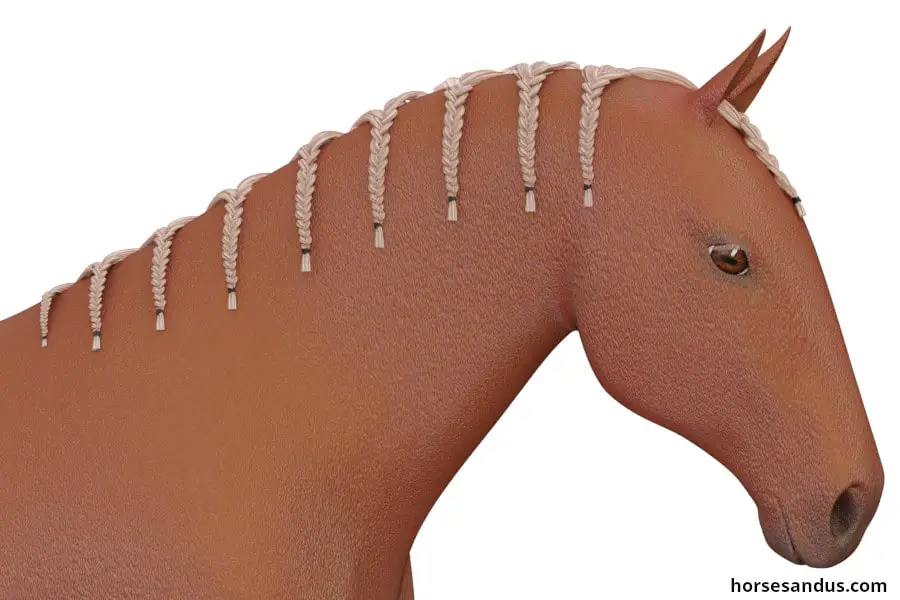
Braids that run in a continuous motion
The running braid is a simple yet elegant style that is perfect for any horse. It’s easy to do and doesn’t take very long, making it a great option if you’re short on time. This style can be done with either the forelock or the main mane, and looks best when the hair is pulled back tight so that it’s smooth and sleek.
To start, brush the hair thoroughly so that there are no knots or tangles. Then, divide the hair into three sections and begin braiding as you would normally. However, instead of finishing off the braid with an elastic band, you’ll need to keep braiding until you reach the end of the mane. Once you get to the end, simply.
The Care and Maintenance of a Long Mane
A horse’s mane is one of the most distinctive features of its appearance. A well-groomed mane adds to the horse’s overall presentation and can be the difference between a winning performance and a lackluster one. While a long mane may take more time and effort to care for, the results are worth it.
Here are some tips on how to care for a long mane:
1. Brush regularly – A daily brushing is necessary to keep the mane tangle-free and looking its best. Use a wide-toothed comb or brush specifically designed for horses’ hair. Start at the bottom of the mane and work your way up, taking care not to pull too hard on the hair.
2. Keep the mane clean and dry – To reduce tangles, wash the mane regularly with a quality shampoo designed for horses, and rinse thoroughly. Towel-dry to remove excess water, then use either a blow dryer or good old fashioned patience to allow the hair to air-dry. Avoid braiding up wet hair as it is more likely to get tangled when you undo it later.
3. Trim only as needed – If your horse’s mane gets too long, have an experienced professional trim it without sacrificing its length. Otherwise, it may be necessary to cut off all of the mane if a major tangle develops that can not be untangled by combing or brushing alone.
Long manes are required in equestrian disciplines where braiding is required.
Breeds such as Morgans, Friesians, and Andalusians often have naturally long manes and tails. While a long mane may be impressive, it’s important to remember that it’s also a high-maintenance hairstyle that requires time, patience, and regular care to look its best.
The 2 Variants Of The Running Braid
There are two main variations of the running braid: the French and Dutch braid. Both styles involve a continuous braid that wraps around multiple sections of the mane, but they differ in how they’re done.
The French braid is typically done on horses with a long forelock, while the Dutch braid works best with a shorter or thinner forelock. To do a French braid, you’ll start at the base of the horse’s forehead and continue braiding until you reach the end of the hair. You can then secure it using an elastic band or other decorative option.
To do a Dutch braid, you’ll begin by dividing your hair into three sections as usual. However, instead of crossing the sections over each other, you’ll simply add hair from the outside of each section. This creates a braid that lays flat along the mane as it wraps around multiple sections.
Whichever variation you choose, the running braid is a simple yet beautiful option for any horse. With just a few basic steps and some practice, you can create stunning looks in no time!
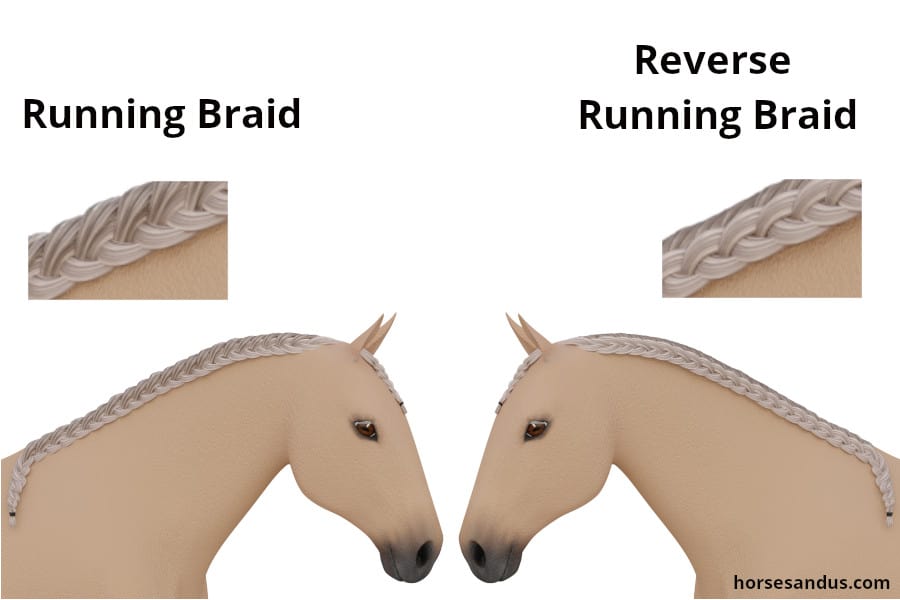
Braids with buttons
Button braids are a popular choice for many western riders, as they offer a unique and stylish look. They’re also relatively easy to do, making them a great option for those who are new to braiding.
To start, brush the hair thoroughly so that there are no knots or tangles. Then, create small sections of hair and begin braiding each one. As you braid, add a small amount of hair from the outside of each section so that it’s slightly thicker than a normal braid. Once you reach the end of the mane, secure the braid with an elastic band or other decorative option.
You can then take the end of the braid and tuck it underneath itself to create a loop, which will act as a button. You can secure the loop by either stitching it down or using another elastic band around the base of the braid.
There are many variations to this style, and you can even add in beads or other decorations to really make your horse stand out. With some practice and experimentation, you’ll be able to create beautiful button braids that your horse will love showing off!
The 2 Variants Of The Button Braids
There are two main variations of the button braid: the single and double braid. Both styles involve a continuous braid that wraps around multiple sections of the mane, but they differ in how many sections are used.
To do a single braid, you’ll start with a small section of hair and begin braiding as usual. However, instead of crossing the sections over each other, you’ll simply add hair from the outside of each section. This creates a braid that lays flat along the mane as it wraps around a single section.
To do a double braid, you’ll begin by dividing your hair into two sections. You’ll then take one section and begin braiding it as usual. As you braid, add a small amount of hair from the outside of each section so that it’s slightly thicker than a normal braid. Once you reach the end of the mane, secure the braid with an elastic band or other decorative option.
You can then take the second section of hair and repeat the process, creating a second braid that wraps around the first. You can then secure both braids together at the base using an elastic band or other decorative option.
There are many variations to this style, and you can even add in beads or other decorations to really make your horse stand out. With some practice and experimentation, you’ll be able to create beautiful button braids that your horse will love showing off!
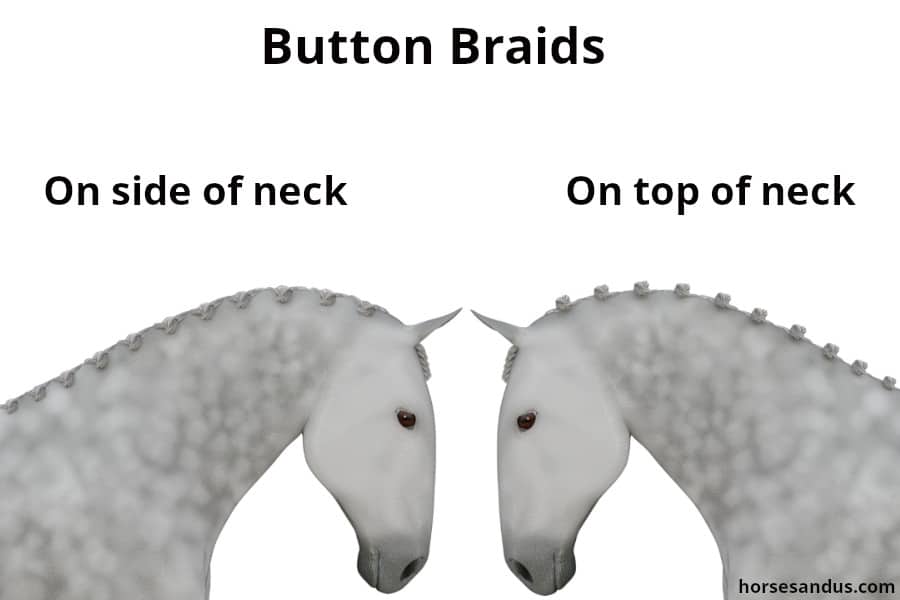
Hunter Braids are a kind of braid that is used for hunting.
A popular choice for hunter riders, the hunter braid is a beautiful and elegant option for any horse. There are many variations of this style, but they all involve braiding a section of hair from both sides so that it encircles the entire neck in one continuous braid.
To begin, brush the mane carefully so there are no tangles or knots. Then, create small sections of hair and start braiding each one individually as usual. When you reach about halfway down the mane, continue braiding two sections at once. This will allow you to create one long braid that circles your horse’s neck and wraps around multiple sections as it continues down the mane.
Many people choose to use decorative elastic bands or other options to secure the braid, as this helps it stay in place as well. You can then add in other decorations like beads or ribbons to make the style really stand out and look great for any type of show.
With some practice and experimentation, you’ll be able to create beautiful hunter braids that your horse will love showing off! Whether you’re a beginner or more experienced rider, these styles are sure to help you create a beautiful and unique mane that will turn heads at any show.
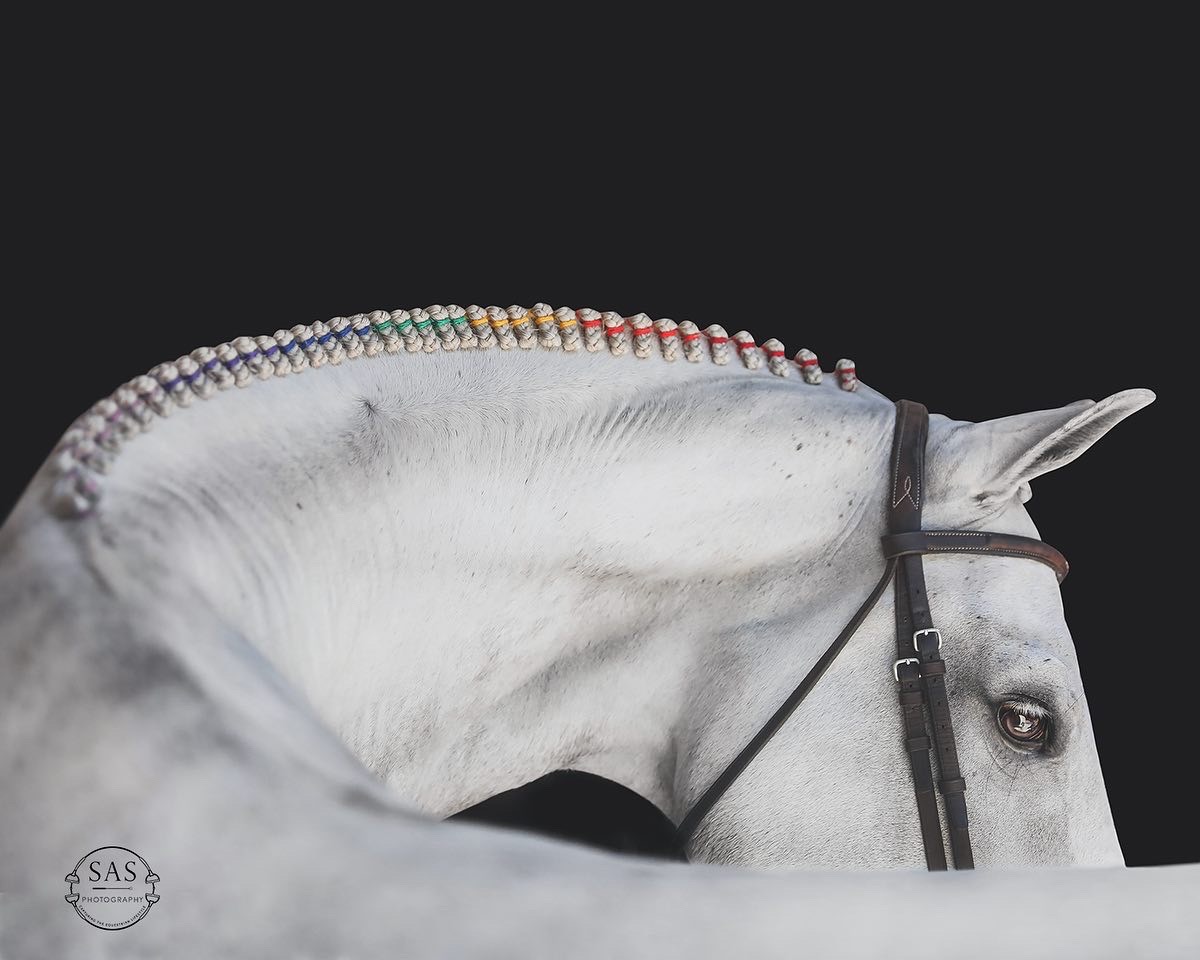
The 2 Variants Of The Hunter Braids
There are many variations to the hunter braid, but they all involve braiding a section of hair from both sides so that it encircles the entire neck in one continuous braid.
There are two main variants of the hunter braid: the traditional style and the running braid style.
The traditional style involves creating a braid that starts at the base of the neck and runs down along the length of the mane. This type of braid is often secured with an elastic band or ribbon at the bottom.
The running braid style is similar to the traditional style, but the braid starts at the base of the neck and runs down along one side of the mane. This type of braid is often secured with an elastic band or ribbon at the bottom and can be left loose or braided into the mane for a more polished look.
Both styles are popular choices for hunter riders and can be used for any type of show. With some practice and experimentation, you’ll be able to create beautiful hunter braids that your horse will love showing off!
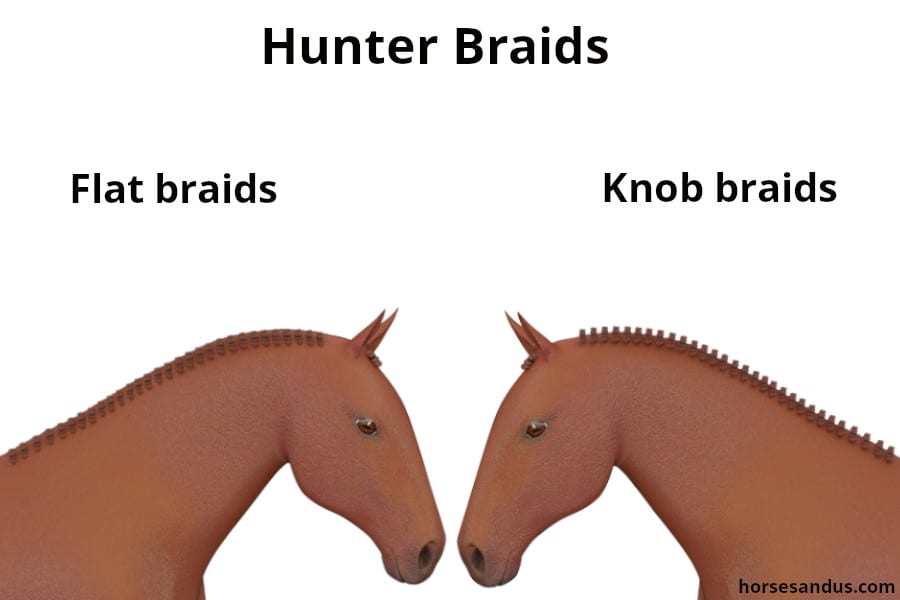
Continental Braid is a kind of braid that is used throughout continental Europe.
The continental braid is a beautiful and elegant option for any horse. This style involves braiding a section of hair from both sides so that it encircles the entire neck in one continuous braid.
To begin, brush the mane carefully so there are no tangles or knots. Then, create small sections of hair and start braiding each one individually as usual. When you reach about halfway down the mane, continue braiding two sections at once. This will allow you to create one long braid that circles your horse’s neck and wraps around multiple sections as it continues down the mane.
Many people choose to use decorative elastic bands or other options to secure the braid, as this helps it stay in place as well. You can then add in other decorations like beads or ribbons to make the style really stand out and look great for any type of show.
With some practice and experimentation, you’ll be able to create beautiful continental braids that your horse will love showing off! Whether you’re a beginner or more experienced rider, these styles are sure to help you create a beautiful and unique mane that will turn heads at any type of show.
Banding the Western Mane
Another popular option for a hunter braid is western mane banding. This style involves sectioning the mane into thin pieces and braiding each piece separately in a traditional braid style.
To begin, brush the mane carefully so there are no tangles or knots. Then, create small sections of hair and start braiding each one individually as usual. When you reach about halfway down the mane, continue braiding two sections at once.
This will allow you to create one long braid that circles your horse’s neck and wraps around multiple sections as it continues down the mane.
Many people choose to use decorative elastic bands or other options to secure the braid, as this helps it stay in place as well. You can then add in other decorations like beads or ribbons to make the style really stand out and look great for any type of show.
With some practice and experimentation, you’ll be able to create beautiful western mane banding that your horse will love showing off! Whether you’re a beginner or more experienced rider, these styles are sure to help you create a beautiful and unique mane that will turn heads at any type of show.
Braids with a Decorative Twist are a traditional design.
They can be as simple or as elaborate as you like, and are a great way to add extra embellishments like beads or flowers to your horse’s mane.
If you have a long-maned horse, the key is keeping it clean, dry, and tangle-free. With regular brushing and proper care, your horse will look its best in any competition!
Decoration for the Lusitano Horse’s Mane
The Lusitano horse is known for its long, flowing mane, which is traditionally styled and decorated in a variety of ways.
Many Lusitano breeders incorporate unique braiding techniques and other decorative elements into the mane, such as beads, feathers, or synthetic hair extensions.
To care for a Lusitano horse’s mane, you will need to brush regularly, keeping the mane clean and dry at all times. This may require washing with a quality shampoo designed specifically for horses, followed by thorough rinsing and careful towel-drying.
Additionally, it is important to trim the mane as needed to avoid major tangles or breakage.
If you are looking for a unique way to style your Lusitano horse’s mane, braiding with a decorative twist is a traditional option that can be as simple or elaborate as you like.
You may also choose to add extra embellishments, such as beads or flowers, to give the mane an even more stylish look. With proper care and regular brushing, your horse’s mane will always look its best!
Decoration for the mane of a Shire Horse
The Shire horse is known for its long, flowing mane, which is commonly decorated in a variety of ways.
Many Shire breeders opt for more traditional styles such as braiding or plaiting the mane, often incorporating intricate techniques and decorative elements like beads, ribbons, or synthetic hair extensions.
To care for a Shire horse’s mane properly, it is important to brush regularly and keep the mane clean and dry at all times. This may require washing with a quality shampoo designed specifically for horses’ hair and careful towel-drying to remove excess water.
Tangled manes and folklore are two things that come to mind.
The Shire horse is a gentle giant, but its long mane can become easily tangled.
To avoid this, it is important to brush the mane regularly and to keep it clean and dry. This may require washing with a quality shampoo designed specifically for horses and careful towel-drying to remove excess water.
If you are looking for a unique way to style your Shire horse’s mane, braiding with a decorative twist is a traditional option that can be as simple or elaborate as you like.
You may also choose to add extra embellishments, such as beads or flowers, to give the mane an even more stylish look. With proper care and regular brushing, your horse’s mane will always look its best!

F.A.Q talk about Western Horse Mane Styles:
What kind of horse has a mane that is wavy?
Their limbs are quite short and powerful in comparison to other animals. A Friesian horse also has a long, thick mane and tail, which are typically wavy, as well as “feather,” which is long, silky hair on the lower legs that is intentionally left untrimmed on the lower legs.
What is a Roached mane, and how does it look?
Roaching a mane is the process of uniformly shaving the whole thing off, all the way down to the base of the neck, where it develops. There are many advantages to using this technique, and it is really rather popular in several sports, such as polo ponies and field hunters.
Conclusion:
While it is important to keep your horse’s mane well-groomed, there are a variety of different styles you can choose from.
Whether you are looking for something sleek and professional or want to show off your cowboy spirit, we have the perfect western horse mane style for you. So get creative and have some fun with your horse’s mane! How will you style your horse’s mane this season?
And this article Westernencounters.com will help you answer questions about Western Horse Mane Styles:
- how to braid horse mane
- reining horse mane
- how to plait a horses mane
- running braid horse mane
- horse tail styles
- horse mane braiding styles
- short horse mane styles
- how to braid horse mane and tail



























